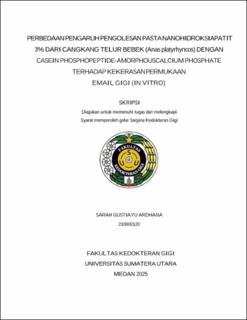| dc.contributor.advisor | Batubara, Fitri Yunita | |
| dc.contributor.author | Ardhana, Sarah Gustiayu | |
| dc.date.accessioned | 2025-03-21T07:41:37Z | |
| dc.date.available | 2025-03-21T07:41:37Z | |
| dc.date.issued | 2025 | |
| dc.identifier.uri | https://repositori.usu.ac.id/handle/123456789/102407 | |
| dc.description.abstract | Caries is a chronic disease that occurs due to the demineralization process, which can reduce the surface hardness of tooth enamel. To overcome this, remineralizing materials are needed, one of which is CPP-ACP. The use of natural materials, such as duck eggshells, as remineralizing agents has been widely studied in various studies. This study aims to determine the difference in the effect of 3% nanohydroxyapatite paste from duck eggshell (Anas platyrhyncos) with CPP-ACP as a remineralizing agent on tooth enamel surface hardness.
This study used 24 premolars that had been extracted, planted on plaster stone with the buccal part facing up, and divided into four groups: Group (I) demineralized and given 3% nanohydroxyapatite paste from duck eggshell, Group (II) demineralized and given CPP-ACP paste, Group (III) demineralized without giving remineralization material, and Group (IV) not demineralized and not given remineralization material. The demineralization and remineralization processes on the samples were carried out for 30 minutes. All samples were then immersed in artificial saliva and stored at 37°C for 14 days. Enamel surface hardness testing was performed using a Microvickers Hardness Tester at three points on the buccal surface of the teeth after demineralization and remineralization.
The results of the paired t-test showed an increase in enamel surface hardness after administration of the test material in each group (p=0.0001). The results of the one-way ANOVA test also showed that the four groups had different effects on increasing enamel surface hardness (p=0.0001). The Post Hoc LSD test showed a
significant difference between the 3% nanohydroxyapatite paste from duck eggshell and CPP-ACP groups (P=0.015). The results of this study indicate that there is a difference in the effect of applying 3% nanohydroxyapatite paste and CPP-ACP on the surface hardness of tooth enamel. | en_US |
| dc.language.iso | id | en_US |
| dc.publisher | Universitas Sumatera Utara | en_US |
| dc.subject | Remineralization | en_US |
| dc.subject | Nanohydroxyapatite | en_US |
| dc.subject | Duck eggshell | en_US |
| dc.subject | Casein Phosphopeptide-Amorphous Calcium Phosphate (CPP-ACP) | en_US |
| dc.subject | Enamel surface hardness. | en_US |
| dc.title | Perbedaan Pengaruh Pengolesan Pasta Nanohidroksiapatit 3% dari Cangkang Telur Bebek (Anas Platyrhyncos) dengan Casein Phosphopeptide-Amorphouscalcium Phosphate terhadap Kekerasan Permukaan Email Gigi (In Vitro) | en_US |
| dc.title.alternative | The Difference in the Effect of Applying 3% Nanohydroxyapatite Paste from Duck Eggshells (Anas platyrhynchos) and Casein Phosphopeptide-Amorphous Calcium Phosphate on the Surface Hardness of Tooth Enamel (In Vitro) | en_US |
| dc.type | Thesis | en_US |
| dc.identifier.nim | NIM210600120 | |
| dc.identifier.nidn | NIDN0026068501 | |
| dc.identifier.kodeprodi | KODEPRODI12201#Pendidikan Dokter Gigi | |
| dc.description.pages | 90 Pages | en_US |
| dc.description.type | Skripsi Sarjana | en_US |
| dc.subject.sdgs | SDGs 3. Good Health And Well Being | en_US |


